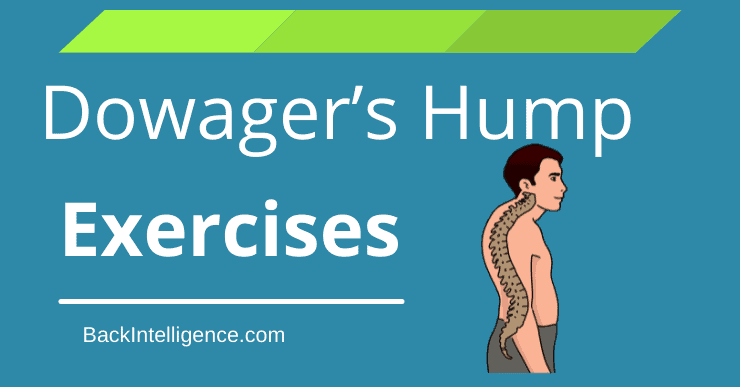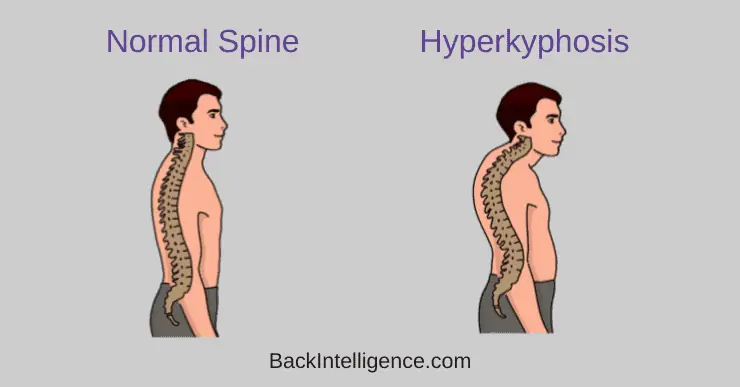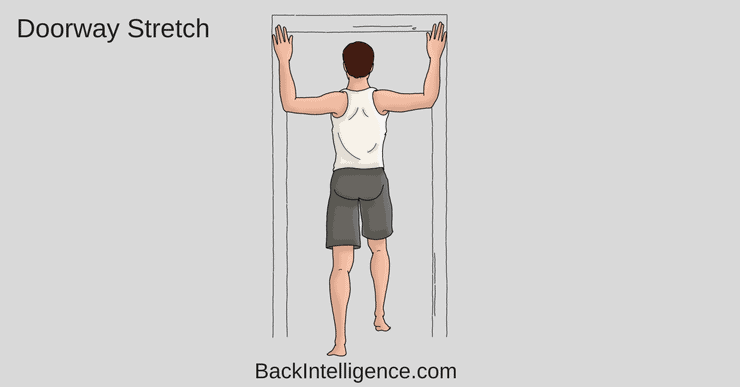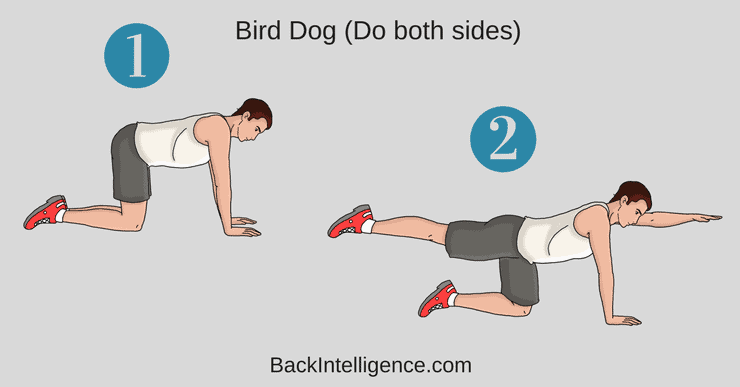
Dowager’s Hump, known under the medical name hyperkyphosis, is a forward rounding in the upper part of the spine (Think excessive rounded shoulders).[1][2][3]
Hyperkyphosis is when the cobb angle of the Thoracic spine is greater than 40 degrees.[1][2] The cobb angle is the standardized measurement of a curve in a spine that is typically used to track the progression of a spine condition.
The percentage of older people living with this condition ranges between 20-40% and it is more common in women than men.[1][3][5] Hyperkyhosis tends to become more severe with age.[1][5]
In addition, according to this study, “Forward head posture, scapula protraction, reduced lumbar lordosis, and decreased standing height are often associated with hyperkyphosis.”[1]
Signs and Symptoms of Dowager’s Hump:
- Hump in upper back[1][2][3]
- Stiffness or back pain[1][2]
- Poor balance, which can lead to falls.[1][3]
- Tight hamstrings[1][2]
- Tight pectoral muscles[2][5]
- Poor posture[1][2][5]
- Difficulty breathing without a history of lung or heart problems due to curvature of spine[2][5]
Causes of Dowager’s Hump:
- Degenerative disc disease[1][5]
- Vertebral fractures[1][5]
- Anterior Wedge Fractures, is a compression fracture occurring on the front part of the vertebrae of the spine[1]
- Decreased disc height from degenerative disc disease. The disc is cartilage that is between two vertebrae in your spine. It is meant to absorb shock.[1][2][3]
- Spinal Extensor Muscle Weakness. These muscles run the length of your back and assist with standing and lifting.[1][2][5]
- Ossification/calcification (hardening) of important ligament on your spine called the Anterior Longitudinal Ligament can increase the degree of hyperkyphosis[1][5]
- Tight pectoral and hip flexor muscles (on the front of your chest and hip muscles respectively)[1]
- Genetics[3][5]
How Do I Diagnose Dowager’s Hump?
The best way to confirm a diagnosis of Dowager’s hump is by using lateral (from the side view) spine X-rays typically performed in a standing position, but can be done while lying down for comfort.[1] This is the best way to confirm the kyphotic angle, but it is not typically used because of the need for imaging.[1] Again, the goal is to see if the thoracic angle is greater than 40 degrees for it to be classified Hyperkyphosis.
Other ways to diagnose that don’t require imaging are using a Debrunner Kyphometer or the flexicurve ruler.[1][2] The Debrunner Kyphometer looks like a protractor and measures the angle of the curve.[2] The flexicurve ruler is a plastic material that can be molded to measure the curve. [1]
Exercises for Dowager’s Hump:
Physical therapy should be tried first before considering other treatment methods such as medications or surgery.[1] Please note, while doing daily activities and exercises you should avoid flexing the spine (bent forward) because it may cause fractures.[1][5] Try to maintain your spine in a neutral position as much as possible.
#1: Thoracic Spine Foam Rolling
This is great way to loosen up the upper back area.
- Lie on your back, with your hands placed behind your head, and a foam roller placed under your upper-back.
- Start to slowly roll up and down beginning at your mid-back and moving towards the top of your shoulders.
- Keep your core tight and use your legs to roll.
- Don’t rush, do nice and slow rolls.
#2: Doorway Pec Stretch:[5]
- Stand in a doorway and place arms up at shoulder height so arms are touching the door frame.
- Take a step forward through the doorway with one foot until you feel a stretch across the front of your shoulders/chest.
- Hold stretch 20-30 seconds, rest then repeat.
- The amount of fwd lunging will determine the amount of stretch you feel.
- If this position is uncomfortable you can place your arms below shoulder level) and repeat the stretch.
The Complete Posture Fix (With Dr. Oliver)
Fix your Rounded shoulders & Fwd Head posture, get out of pain and increase your mobility.
Learn More
#3: Bird Dog:[1][3][5]
This is a great exercise to improve core strength and lumbar back muscles.
How to do it:
– Begin on your hands and knees, with your hands positioned under your shoulders and knees positioned under your hips.
– Brace (contract) your core as hard as you can before beginning any movement.
– While bracing your core, raise your left arm and reach it forwards until it is aligned with your torso; at the same time, kick your right leg backwards until is it aligned with your torso.
– It’s important to not arch your low back as you do this.
– Hold this position for 2-3 seconds before slowly returning to the starting position.
– Repeat with your right arm and left leg.
– Alternate sides for 10 repetitions.
** Only extend your arm and leg to where it’s comfortable and don’t arch your low back.
#4: Self Mobilization on Foam Roller[1][5]
- Lie on foam roller vertically so it runs the length of your spine – between your shoulder blades.
- Plant your feet on the ground with your knees bent to help with balance.
- Extend your hands backwards behind your head with elbows bent or let them hang down in a Y position (whichever is more comfortable) and relax into the position. Think about letting your elbows fall backwards towards the floor.
- Let your arms feel heavy and your back sink into the mat. Take deep breaths and focus on your breathing.
- Complete activity x 5 minutes to improve spinal mobility.
#5: Chin Tucks
This exercise will activate and strengthen your deep cervical muscles (front of the neck muscles).
- Place 2 fingers at the bottom of your chin.
- Gently tuck your chin in and retract your head backwards. At the same time, use your fingers to keep the chin tucked in the entire time.
- Hold the end position for 3 to 5 seconds.
- Relax your neck for a moment (Let the neck come fwd).
- Aim for 2 to 3 sets of 10 repetitions.
** You should feel like the back of your neck is lengthening or “pulling up”, and there will be packing in front of your neck.
Learn More
Related:
Forward Head Posture
Study On: Effects of SmartPhones on Posture & Breathing
Posture Correction Exercises
A Better Door Frame Stretch – Open Up Your Chest
How Can Poor Posture Result in Back Pain – 7 Causes
How To Do Chin Tucks Exercise Correctly (Video)
Sources:
[1] Katzman WB, Wanek L, Shepherd JA, et al. Age-related hyperkyphosis: its causes, consequences, and management. J Orthop Sports Phys Ther. 2010; 40(6): 352-360. doi: 10.2519/jospt.2010.3099
[2] Greendale GA, Huang MH, Karlamangla AS, et al.. Yoga decreases kyphosis in senior women and men with adult onset hyperkyphosis: results of a randomized controlled trial. J AM Geriatr Soc. 2009; 57(9): 1569-1579. doi: 10.1111/j.1532-5415.2009.02391.x
[3] Yau MS, Demissie S, Zhou Y, et al. Heritability of thoracic spine curvature and genetic correlations with other spine traits: the framingham study. J Bone Miner Res. 2016; 31(12): 2077-2084. doi: 10.1002/jbmr.2925.
Doctor of Physical Therapy and currently works full time as a pediatric physical therapist. Rachel has worked in Sports, Inpatient Rehab and Outpatient Ortho settings under the guidance of incredible mentors focusing on low back pain. Rachel believes in holistic and patient centered care and enjoys developing their course of treatment.







